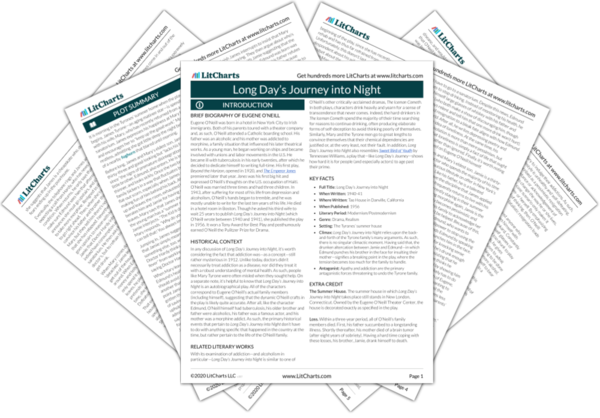Welcome to the LitCharts study guide on Eugene O’Neill's Long Day’s Journey into Night. Created by the original team behind SparkNotes, LitCharts are the world's best literature guides.
Long Day’s Journey into Night: Introduction
A concise biography of Eugene O’Neill plus historical and literary context for Long Day’s Journey into Night.
Long Day’s Journey into Night: Plot Summary
A quick-reference summary: Long Day’s Journey into Night on a single page.
Long Day’s Journey into Night: Detailed Summary & Analysis
In-depth summary and analysis of every act of Long Day’s Journey into Night. Visual theme-tracking, too.
Long Day’s Journey into Night: Themes
Explanations, analysis, and visualizations of Long Day’s Journey into Night's themes.
Long Day’s Journey into Night: Quotes
Long Day’s Journey into Night's important quotes, sortable by theme, character, or act.
Long Day’s Journey into Night: Characters
Description, analysis, and timelines for Long Day’s Journey into Night's characters.
Long Day’s Journey into Night: Symbols
Explanations of Long Day’s Journey into Night's symbols, and tracking of where they appear.
Long Day’s Journey into Night: Theme Wheel
An interactive data visualization of Long Day’s Journey into Night's plot and themes.
Brief Biography of Eugene O’Neill
Eugene O’Neill was born in a hotel in New York City to Irish immigrants. Both of his parents toured with a theater company and, as such, O’Neill attended a Catholic boarding school. His father was an alcoholic and his mother was addicted to morphine, a family situation that influenced his later theatrical works. As a young man, he began working on ships and became involved with unions and labor movements in the U.S. He became ill with tuberculosis in his early twenties, after which he decided to dedicate himself to writing full-time. His first play, Beyond the Horizon, opened in 1920, and The Emperor Jones premiered later that year. Jones was his first big hit and expressed O’Neill’s thoughts on the U.S. occupation of Haiti. O’Neill was married three times and had three children. In 1943, after suffering for most of his life from depression and alcoholism, O’Neill’s hands began to tremble, and he was mostly unable to write for the last ten years of his life. He died in a hotel room in Boston. Though he asked his third wife to wait 25 years to publish Long Day’s Journey into Night (which O’Neill wrote between 1940 and 1941), she published the play in 1956. It won a Tony Award for Best Play and posthumously earned O’Neill the Pulitzer Prize for Drama.
Get the entire Long Day’s Journey into Night LitChart as a printable PDF.

Historical Context of Long Day’s Journey into Night
In any discussion of Long Day’s Journey into Night, it’s worth considering the fact that addiction was—as a concept—still rather mysterious in 1912. Unlike today, doctors didn’t necessarily treat addiction as a disease, nor did they treat it with a robust understanding of mental health. As such, people like Mary Tyrone were often misled when they sought help. On a separate note, it’s helpful to know that Long Day’s Journey into Night is an autobiographical play. All of the characters correspond to Eugene O’Neill’s actual family members (including himself), suggesting that the dynamic O’Neill crafts in the play is likely quite accurate. After all, like the character Edmund, O’Neill himself had tuberculosis, his older brother and father were alcoholics, his father was a famous actor, and his mother was a morphine addict. As such, the primary historical events that pertain to Long Day’s Journey into Night don’t have to do with anything specific that happened in the country at the time, but rather pertain to the life of the O’Neill family.
Other Books Related to Long Day’s Journey into Night
With its examination of addiction—and alcoholism in particular—Long Day’s Journey into Night is similar to one of O’Neill’s other critically-acclaimed dramas, The Iceman Cometh. In both plays, characters drink heavily and yearn for a sense of transcendence that never comes. Indeed, the hard-drinkers in The Iceman Cometh spend the majority of their time searching for reasons to continue drinking, often producing elaborate forms of self-deception to avoid thinking poorly of themselves. Similarly, Mary and the Tyrone men go to great lengths to convince themselves that their chemical dependencies are justified or, at the very least, not their fault. In addition, Long Day’s Journey into Night also resembles Sweet Bird of Youth by Tennessee Williams, a play that—like Long Day’s Journey—shows how hard it is for people (and especially actors) to age past their prime.
Key Facts about Long Day’s Journey into Night
- Full Title: Long Day’s Journey into Night
- When Written: 1940-41
- Where Written: Tao House in Danville, California
- When Published: 1956
- Literary Period: Modernism/Postmodernism
- Genre: Drama, Realism
- Setting: The Tyrones’ summer house
- Climax: Long Day’s Journey into Night relies upon the back-and-forth of the Tyrone family’s many arguments. As such, there is no singular climactic moment. Having said that, the drunken altercation between Jamie and Edmund—in which Edmund punches his brother in the face for insulting their mother—signifies a breaking point in the play, where the tension becomes too much for the family to handle.
- Antagonist: Apathy and addiction are the primary antagonistic forces threatening to undo the Tyrone family.
Extra Credit for Long Day’s Journey into Night
The Summer House. The summer house in which Long Day’s Journey into Night takes place still stands in New London, Connecticut. Owned by the Eugene O’Neill Theater Center, the house is decorated exactly as specified in the play.
Loss. Within a three-year period, all of O’Neill’s family members died. First, his father succumbed to a longstanding illness. Shortly thereafter, his mother died of a brain tumor (after eight years of sobriety). Having a hard time coping with these losses, his brother, Jamie, drank himself to death.












